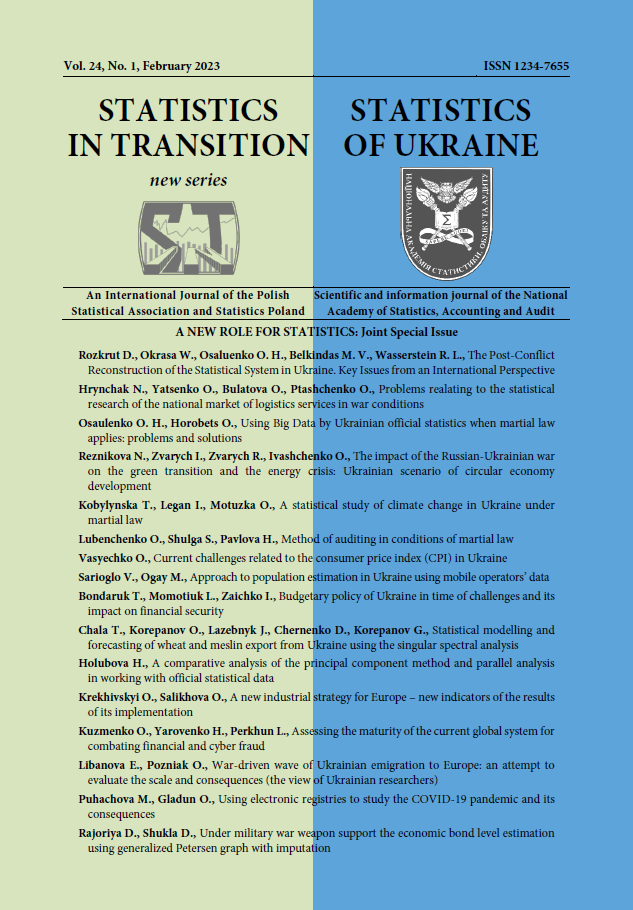ARTICLE
ABSTRACT
The article is focused on issues of the secure operation of official statistics in Ukraine during the application of martial law. It was found that the gaps in conventional sources of statistical data caused by the war needed to be filled with data from alternative sources, including Big Data. The level of digitalisation in Ukraine as the basis for using Big Data was analysed by the proposed indices of internetisation, social progress and digital transformation. Thanks to our research, several problems (methodological, legal, financial, and managerial) were identified as vital for statistical offices on their way to the implementation of Big Data in statistical processes. Our proposals concern tools for Big Data processing, such as Data Hypercube as a way for presenting Big Data for their visualisation, applications of Web scraping in estimating the consumer prices index, analyses of labour and real estate markets, and the applications of specialised software for the collection, processing and analysis of Big Data sets
KEYWORDS
official statistics, statistics during war, Big Data, digitalisation
REFERENCES
Bentein, A., (2021). Data is the New Gold. Retrieved from: https://www.qad.com/blog/2021/04/data-is-the-newgold#:~: text=Are%20the%20phrases%20%E2%80%9Cdata%20is,spend%20more %20money%20on%20technology%3F
Cai, L., Qi, Y., Wei, W., Wu, J., Li, J., (2019). mrMoulder: A recommendation-based adaptive parameter tuning approach for big data processing platform Future Gener. Comput. Syst., 93, pp. 570-582.
Codd, E. F., (1985). Is Your DBMS Really Relational? ComputerWorld.
Codd, E. F., Codd, S. B. and Salley, C. T., (1993). Providing OLAP to User-Analysts: An IT Mandate. Retrieved from: https://web.archive.org/web/20170808214004/https://www.minet.unijena. de/dbis/lehre/ss2005/sem_dwh/lit/Cod93.pdf
Cox, M., Ellsworth, D., (1997). Application-controlled demand paging for out-of-core visualization. Proceedings of the 8th conference on Visualization’97, pp. 235–247.
Chen, C. L. Philip and Zhang, C.-Ya, (2014). Data-intensive applications, challenges, techniques and technologies: A survey on Big Data. Information Science, 275, pp. 314–347.
Diebold, F. X., (2003). Big Data' Dynamic Factor Models for Macroeconomic Measurement and Forecasting. (Discussion of Reichlin and Watson papers), in M. Dewatripont, L.P. Hansen and S.Turnovsky (Eds.), Advances in Economics and Econometrics, Eighth World Congress of the Econometric Society. Cambridge: Cambridge University Press, pp. 115–122.
Dogucu, M., Çetinkaya-Rundel, M., (2021). Web Scraping in the Statistics and Data Science Curriculum: Challenges and Opportunities. Journal of Statistics and Data Science Education, Vol. 29, pp. 112–122.
ESP Rome, (2014). Collaboration in Research and Methodology for Official Statistics (CROS). Retrieved from: https://ec.europa.eu/eurostat/cros/content/esp-rome- 2014_en.
European Commission, (2022). Data Act: Proposal for a Regulation on harmonised rules on fair access to and use of data. Retrieved from: https://digitalstrategy. ec.europa.eu/en/library/data-act-proposal-regulation-harmonised-rulesfair- access-and-use-data.
European Commission, A European Strategy for data. Retrieved from: https://digitalstrategy. ec.europa.eu/en/policies/strategy-data.
European Commission. (2020). Communication from the Commission to the European Parliament, the Council, the European economic and social committee and the Committee of the regions a European strategy for data. COM/2020/66 final. Retrieved from: https://eur-lex.europa.eu/legal-content/EN/TXT/?uri=CELEX%3A52020DC0066.
Gartner Glossary, (2022). Big Data. Retrieved from: https://www.gartner.com/itglossary/ big-data/.
Gartner Glossary, (2022a). Dark Data. Retrieved from: https://www.gartner.com/itglossary/ dark-datahttps://www.gartner.com/it-glossary/dark-data.
Geneva, (12 August 1949). Convention (IV) relative to the Protection of Civilian Persons in Time of War. Retrieved from: https://ihl-databases.icrc.org/ applic/ihl/ihl.nsf/Treaty.xsp?documentId=AE2D398352C5B028C12563CD002D6 B5C&action=openDocument.
Global Index: Overview. Social Progress Imperative. Retrieved from: https://www.socialprogress.org/index/global.
Henriques, A., (2022). Mind the gaps: how experience data can help fight climate change. World Economic Forum. Retrieved from: https://www.weforum.org/ agenda/2022/02/climate-change-experience-data/.
Kenglung H., (2022). Big data analysis and optimization and platform components. Journal of King Saud University – Science. Vol. 34. Issue 4. Retrieved from: https://www.sciencedirect.com/science/article/pii/S1018364722001264#b0015.
Marchand, P., Brisebois ?., Bédard Y. and Edwards, G., (2003). Implementation and evaluation of a hypercube-based method for spatio-temporal exploration and analysis. Workshop ISPRS, Québec, Canada.
Mayer-Schönberger, V., Cukier, K., (2013). Big data: A revolution that will transform how we live, work, and think. Houghton Mifflin Harcourt. Retrieved from: https://psycnet.apa.org/record/2013-17650-000/.
Ministry of Digital Transformation of Ukraine, (2022). Mykhailo Fedorov explains about recognizing the faces of the Russian occupiers. [Mykhaylo Fedorov poyasnyuye pro rozpiznavannya oblych rosiys'kykh okupantiv]. Retrieved from: https://www.kmu.gov.ua/news/mihajlo-fedorov-pro-rozpiznavannya-oblichrosijskih- okupantiv [in Ukrainian].
OECD, (2017). Going Digital: Making the Transformation Work for Growth and Well- Being: Meeteng of the OECD Council at Ministerial Level. Retrieved from: https://www.oecd.org/mcm/documents/C-MIN-2017-4%20EN.pdf.
Oxford Learner’s Dictionaries, (2022). Big Data. Retrieved from: https://www.oxfordlearnersdictionaries.com/us/definition/english/big-data.
Polidoro, F., Giannini, R., Conte R. L., Mosca, S. and Rossetti, F., (2015). Web scraping techniques to collect data on consumer electronics and airfares for Italian HICP compilation. Statistical Journal of the IAOS, 31(2), pp. 165-176.
Summa, D., Bianchi, G., Consalvi, M., Gentili, B., Pancella, F. and Scalfati, F., (2019). Using Big Data for Official Statistics: Web Scraping as a Data Source for Statistical Business Registers (SBRs). NTTS2019. Retrieved from: https://coms.events/ntts2019/data/abstracts/en/abstract_0007.html.
United Nations, (2013). Big Data and modernization of statistical systems. United Nations Economic and Social Council. Report of the Secretary-General. Forty-fifth session of the UN Statistical Commission, NY, 4-7 March 2014, doc. E/CN.3/2014/11, December, New York, pp. 1–16.
United Nations. Economic and Social Commission for Western Asia, (2021). Use of Big Data in Compilation of SDG Indicators in the Arab Region, Challenges and Opportunities. Retrieved from: https://www.unescwa.org/sites/default/files/pubs/pdf/big-data-compilation-sdgindicators- arab-region-challenges-opportunities-english.pdf.
United Nations Statistics Devision, (2014). Fundamental Principles of Official Statistics (A/RES/68/261 from 29 January 2014). Retrieved from: https://unstats.un.org/ unsd/dnss/gp/fundprinciples.aspx.
Weiss, S. M., Indurkhya, N., (1998). Predictive data mining: a practical guide. Morgan Kaufmann Publishers, 1997, pp. 44–48.
Wiltshire, D., Alvanides, S., (2022). Ensuring the ethical use of Big Data: lessons from secure data access, Heliyon, Vol. 1. Issue, 2. pp. 1–6.
Wu, C., Buyya R., Ramamohanarao, K., (2016). Chapter 1. Big Data Analytics = Machine Learning + Cloud Computing. Big Data Principles and Paradigms, Elsevier, pp. 3–38.
